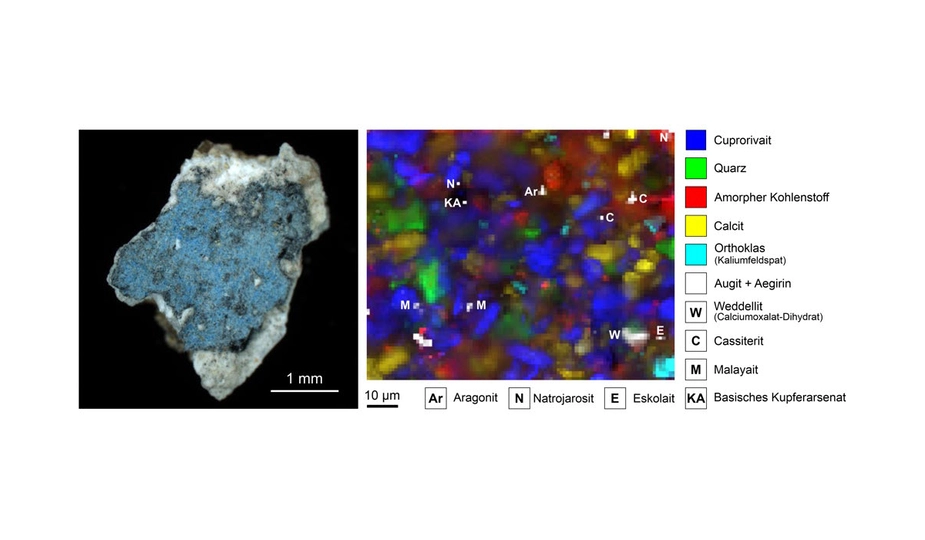Research team elucidates complex spectrum of trace compounds in the first artificial pigment of mankind
Early Medieval Egyptian blue in laser light
Art technologist Dr. Petra Dariz and analytical chemist Dr. Thomas Schmid (School of Analytical Sciences Adlershof SALSA at Humboldt-Universität zu Berlin and Bundesanstalt für Materialforschung und -prüfung BAM) identified Egyptian blue on a monochrome blue mural fragment, which was excavated in the church of St. Peter above Gratsch (South Tyrol, Northern Italy) in the 1970s. The fragment was preserved in the archive of finds of the office for archaeology of the autonomous province of South Tyrol and served as a reference material for age determination within the frame of a research project on Early Medieval stucco fragments of this church, co-funded by the South Tyrolean provincial museums. The two researchers originally stemming from South Tyrol conducted the project in the laboratories of SALSA and BAM in Berlin (Germany). The results were published in the Nature Research journal Scientific Reports.
Egyptian blue can be synthesised by heating a raw material mixture consisting of quartz sand, limestone, copper ore and a flux (soda or plant ash) to about 950°C. Around the turn of the eras, Roman sources report that a certain Vestorius transferred the originally Egyptian technology to Pozzuoli. In fact, archaeological evidences confirm production sites in the northern Phlegraean Fields near Naples (Campania, Southern Italy) and seem to indicate a monopoly in the manufacture and trade of pigment spheres. Due to its almost exclusive use, Egyptian blue is the blue pigment par excellence of Roman antiquity; its art technological traces vanish in the course of the Middle Ages.
Finding each needle in a haystack
Since the rediscovery of Egyptian blue in the context of Napoleon’s Egyptian campaign and the excavations in Pompeii and Herculaneum around 200 years ago the pigment has exerted an unbroken fascination, triggering numerous subsequent research works. Only within the last decade, petrographic investigations were included with the aim to characterise and differentiate possible production sites. Conventional analytical approaches applied so far, were limited to components with contents of more than one percent, because finely distributed minerals in powdered samples behave like the proverbial needle in a haystack.
In earlier studies on historical mortar materials, the team employed Raman microscopy as new method to reconstruct technical process parameters and the origin of the raw materials. Based on these experiences, the application of this technique appeared promising for the detection of potential trace compounds in Egyptian blue. Extensive scanning of the paint layer with a laser beam focused to around a thousandth of a millimetre and the spectroscopic identification of minerals at each individual measurement spot ensured to find even the smallest information carriers.
The individual “biography” of a colourant
The results were beyond all expectations. In 166,477 individual measurements, 28 different minerals with contents from the percent range down to 0.1 permille were identified. Inclusion of knowledge from neighbouring disciplines made possible to read out the information about the type and provenance of the raw materials, synthesis and application of the pigment and ageing of the paint layer preserved in the trace components, and thus to reconstruct the individual "biography" of the Egyptian blue from St. Peter. This multifaceted insight represents a paradigm shift in the research history, at the same time raising new research questions.
Particularly noteworthy are minerals associated with volcanic activity, which according to the composition of beach sands at the Gulf of Gaeta, indicate a production of the pigment in the northern Phlegraean Fields. Furthermore, indicators for a sulphidic copper ore (instead of often-mentioned metallic copper or bronze) and plant ash as flux in the raw material mixture were found. Comparable Raman microscopic analyses of Egyptian blue in Roman and Medieval wall paintings and of pigment spheres could finally provide a sound scientific evidence for the assumed manufacturing monopoly in Pozzuoli surviving over centuries after the fall of the Western Roman Empire.
Publication
P. Dariz, T. Schmid, Trace compounds in Early Medieval Egyptian blue carry information on provenance, manufacture, application, and ageing.
Scientific Reports 2021, 11, 11296. www.nature.com/articles/s41598-021-90759-6
Contact:
Dr. Thomas Schmid
School of Analytical Sciences Adlershof (SALSA)
Head Application Lab
Email: thomas.schmid(at)bam.de
www.salsa.hu-berlin.de
Press release, Humboldt-Universität zu Berlin, 2 June 2021
